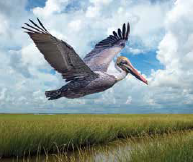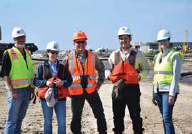It’s been fifty-one years since the brown pelican was reintroduced to Louisiana after the species completely disappeared from the state due to pesticide use in the 1960s. Since then, the pelicans have thrived on Queen Bess Island, making it the third largest brown pelican rookery in Louisiana. Another battle looms, however.
Louisiana’s state bird, the brown pelican.
 Over the years, Queen Bess Island has been sinking and eroding into the Gulf of Mexico, leaving less than five acres of suitable land for the pelicans to nest. Racing against the clock, engineers like biological engineering alumna Amanda Phillips are working to restore the island’s nesting area to its once-vast size, giving the state bird another chance to prosper. “This project is different than others,” Phillips, a coastal engineer for Fenstermaker in New Orleans, said. “In many respects, a lot of the projects that have been constructed over the years have been general sense-type projects. But with this project, you had something to identify with – pelican and tern habitat. It’s tangible.”
Over the years, Queen Bess Island has been sinking and eroding into the Gulf of Mexico, leaving less than five acres of suitable land for the pelicans to nest. Racing against the clock, engineers like biological engineering alumna Amanda Phillips are working to restore the island’s nesting area to its once-vast size, giving the state bird another chance to prosper. “This project is different than others,” Phillips, a coastal engineer for Fenstermaker in New Orleans, said. “In many respects, a lot of the projects that have been constructed over the years have been general sense-type projects. But with this project, you had something to identify with – pelican and tern habitat. It’s tangible.”
Queen Bess Island, a patch of land about two miles north of Grand Isle in Barataria Bay, produces 15-20 percent of the state’s brown pelican nesting activity. The island is also home to sixty other bird species, among them egrets, herons, terns, gulls, roseate spoonbills, ibis, and others. During breeding season, a few thousand pelicans crowd onto five acres of land surrounded by old rock barriers. The goal of the restoration project, which Phillips has been working on since 2017, is to provide a quality habitat for these birds to nest.
Working alongside the Louisiana Department of Wildlife and Fisheries, Coastal Protection and Restoration Authority, and the U.S. Departments of Fish and Wildlife Services, Phillips designed the best way to restore and design the island in a small amount of time. “One of the nuisances of this project is they did not want any construction occurring when the birds show up to nest,” Phillips said. “There could be large ramifications if their nesting were affected. Wildlife and Fisheries really wanted the construction to happen after nesting season, which is after Sept. 15, and before nesting season started on March 15.”
The project was approved in March 2019, a contract was awarded by June, and on Aug. 1 the contractor was able to take plant samples and start growing them in a greenhouse to later replant on Queen Bess Island. “It ended up going very smoothly and worked out well, which is a testament to all the people involved and knowing this project was so critical,” Phillips said.

Some of the Queen Bess Island project team members are, from left, Garvin Pittman (1992 BACH ENGR), Katie Freer, Todd Baker (2015 BACH ENGR), Jacques Boudreaux (2009 BACH ENGR, 2012 MAST ENGR), and Amanda Philips (2000 BACH ENGR).
Now in the final stages of completion, the Queen Bess Island project will provide thirty acres of restored brown pelican and wading bird habitat, along with seven acres of nesting tern and black skimmer habitat. “It’s not a very large island, but it is isolated, so there aren’t any predators on it,” Phillips said. “It’s very safe, and that’s what makes it special.”
The restoration is expected to last at least twenty years, with money set aside for necessary upgrades. The $18.7 million project comes nearly ten years after the Deepwater Horizon oil spill in the Gulf, and it is part of the billion-dollar settlement from British Petroleum.
When all is said and done, Phillips will have had a hand in saving Louisiana’s state bird. “We all recognize this to be an ongoing issue, and we were able to bring our various skills to the table and develop a project that we are all proud of,” Phillips said. “It makes me beam every time I talk about this project because it has such a potential positive. It may help people have a better understanding of what coastal restoration and engineering is all about.”
Libby Haydel is a communications specialist at LSU Strategic Communications.
This story is part of a story from the Summer 2020 issue of LSU Alumni Magazine. If you would like to receive future issues of our print publication become a member of LSU Alumni Association.